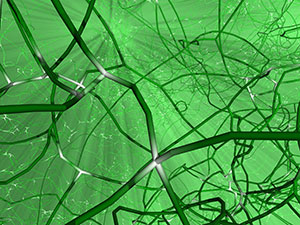Dislocation dynamics simulation using the
ParaDiS code.
LLNL develops microscopic and macroscopic models of physics and material properties, as well as improved numerical approximations to the simulation of transport for particles and xrays and other critical phenomena. Development, the initial validation, and the incorporation of new models into the Integrated Codes requires that both subprograms be interdependent. There is also extensive integration with the Stockpile Stewardship Program experimental programs, mostly funded and managed by the Science Campaigns (Dynamic Materials Properties) and the Engineering Campaign. Functional requirements for the models are established by designers and analysts.
Areas include:
- Materials Response: Equation of State, Materials, High Explosives, and Mix and Burn
Development and implementation of science-based predictive models, including physics discovery at different length and time scales, for the dynamic response of materials used in ASC codes for performance and safety simulation. This research area includes models at normal and extreme conditions for describing the thermodynamic response of materials; the dynamic strength, damage, and failure response of materials; the dynamics of high explosives and polymers; and the evolution of complex hydrodynamic and burning flows. It also includes capabilities to predict the change of property, geometry, and function of material due to aging. Research in this area requires the integration of advanced theory, specialized computer codes and experimental data, and provides cross-program support for new model implementation and verification in ASC codes for improved predictive capability. - Transport, Plasmas, Atomic, Nuclear
Delivery of accurate nuclear cross-section evaluations and databases for science-based models and databases that represent the interactions of radiation with matter and for the behavior of plasmas and transport phenomena (thermal, radiation, electrical) at extreme temperatures, pressures, and densities. The nuclear properties and opacity databases are produced in forms sharable between ASC partners. Specialized nuclear physics codes integrate experiments and advanced theory. For opacity calculations, both equilibrium and non-equilibrium models calculate data in an ab initio manner. Research in this area supports the implementation of models and databases into ASC integrated safety, design, and diagnostics codes for improved predictive capability. - Engineering Science, Environments, and Response
Delivery of predictive science-based models that describe complex thermal, mechanical, electrical, chemical, and fluid transport in materials for component manufacturing and performance; complex aerodynamic and aerothermal flows and response for gravity and reentry systems; and material and electrical system effects produced by exposure to electromagnetic pulses both external and internal, x-ray, gamma, and/or neutron radiation. Models are developed through integration of theory, computational simulation, and analyses of experimental data. The resulting models are implemented into ASC integrated engineering and physics codes for improved predictive capability. - Integrated Modeling and Application
Support for efficient use of models in ASC codes, including the need to address technology mitigation issues for all physics and engineering models in new hardware architectures and implementation of models in next-generation codes, along with ensuring the robustness of models when integrated in multi-physics simulations.





